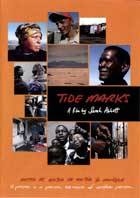
Tide Marks: Legacies of Apartheid 2004
Distributed by Canadian Filmmakers Distribution Centre, 401 Richmond St. W., Suite 119, Toronto, Ontario, Canada M5V 3A8; 416-588-0725
Produced by Sarah Abbott
Directed by Sarah Abbott
DVD, color, 97 min.
College - Adult
African Studies, Apartheid
Date Entered: 08/20/2009
Reviewed by Miriam Conteh-Morgan, The Ohio State University Libraries, Columbus, OHThe horrors of the physical ill-treatment of South Africa’s Black and Coloured populations during apartheid may have ended but the scars persist in the emotional, psychological and economic lives of many, as the documentary Tide Marks: Legacies of Apartheid shows. Abbott conducts extensive interviews with four individuals, selected to represent gender, race, class and economic situation. She blends these with photo slides and text of other personal accounts to reconstruct historical events and attitudes, and to provide a background for understanding why millions of present-day South Africans live the way they do.
What all four of interviewees share is their involvement in the anti-apartheid struggle and their disillusionment with the current state of affairs. As one of them, Maureen ironically puts it, freedom may have arrived, but those who were in the trenches of that fight have yet to savor the fruit of their labor. Viewers learn, for example, that some with disabilities struggle against bureaucracies for the payment of their social benefits; that some who went into exile now seem to enjoy the perks of life in the free South Africa, while those who stayed behind or were imprisoned continue to eke out a life in shanty towns; and that the majority of the freedom fighters deferred education and professional dreams to engage in the fight, yet their children lack those same opportunities in a free country.
The stories are evocative and haunting but they could have been told in less than 90-plus minutes. For example, Brian’s interviews could have been edited to cut out repetitions; nor is it clear how much the sightseeing tour of the market with Colin really adds to the overall narrative. Also, Abbott should have considered using subtitles because the interviewees’ accent does not always make their stories accessible, and this may pose difficulties in a non-African classroom. But these are not egregious enough to detract from the powerful personal stories of a group of people who are not always written into the freedom narratives of South Africa.